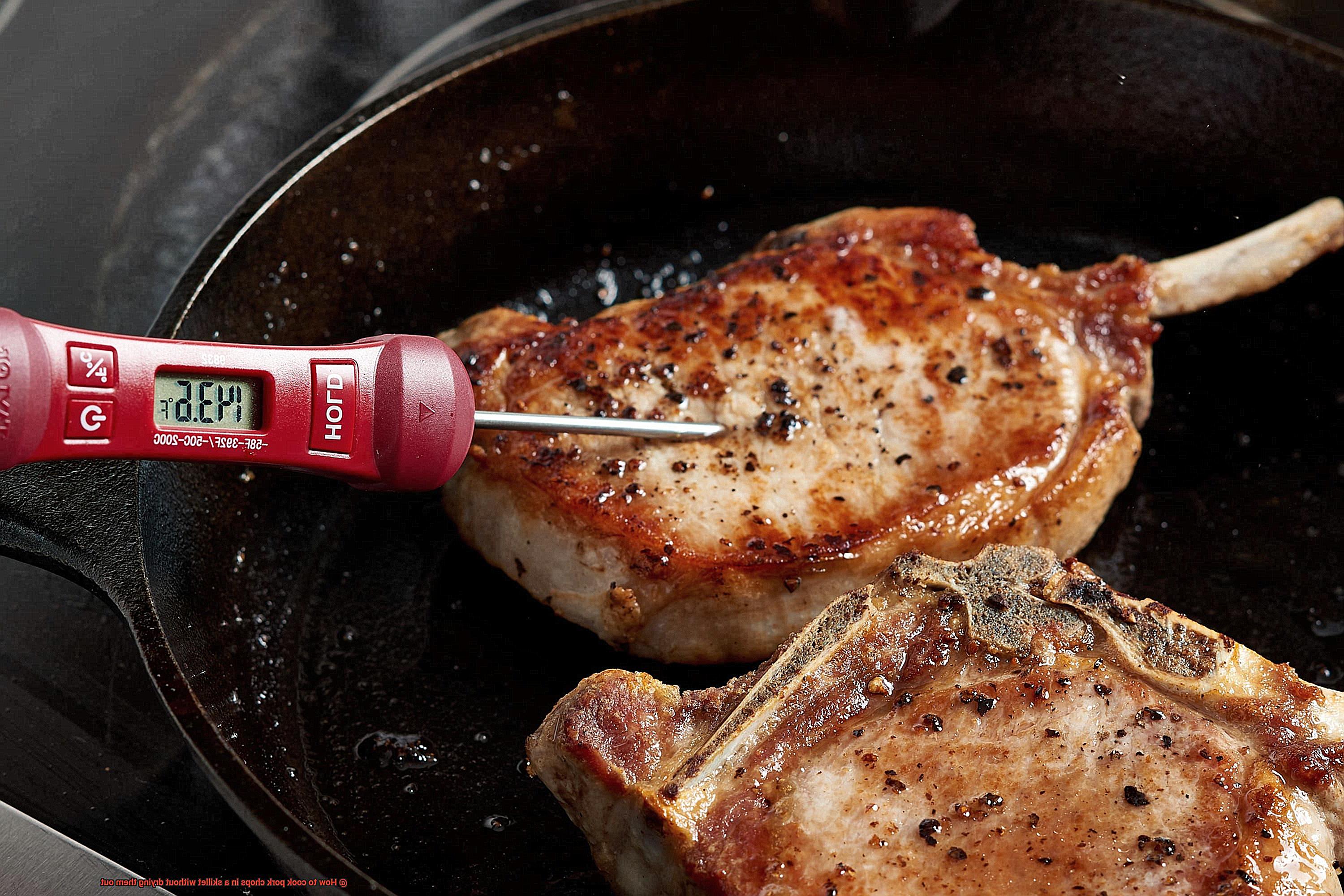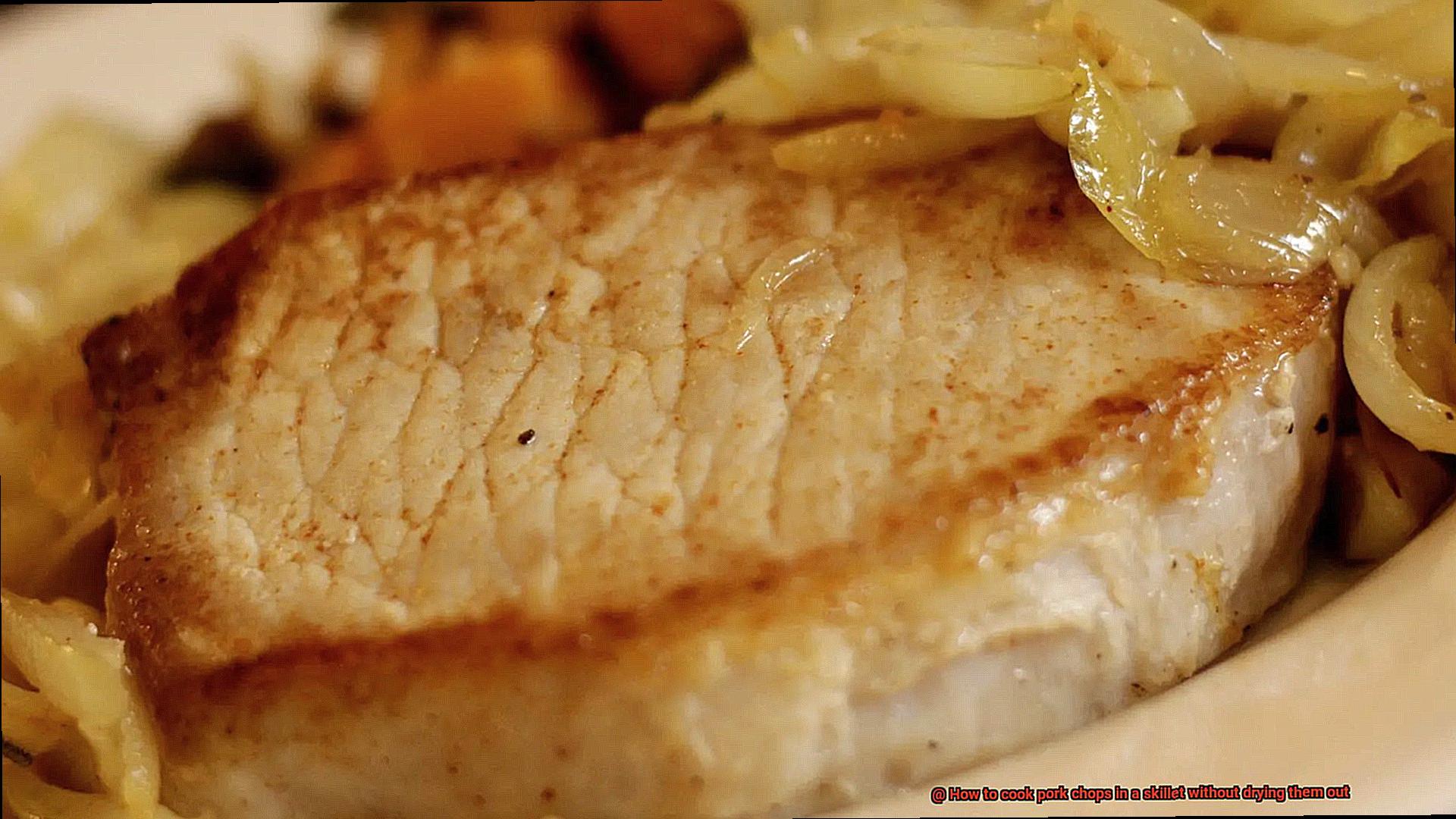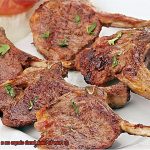Who doesn’t love a perfectly cooked pork chop? It’s juicy, succulent, and oh-so-delicious. But let’s face it; pork chops can be tricky to cook without drying them out. Fear not. With a few simple tricks, you can cook pork chops in a skillet like a pro.
First things first: choose the right cut of pork chop. Look for cuts with good marbling and fat content. This will ensure that your pork chops stay moist and flavorful throughout the cooking process. Next, allow your pork chops to come up to room temperature before cooking. This step is crucial because it ensures even cooking and prevents the center from being cold and undercooked.
Now it’s time to season those bad boys up. Salt, pepper, and herbs are all great options for adding extra flavor to your pork chops. Once they’re seasoned to perfection, heat up a cast-iron or stainless-steel skillet until it’s hot. Add oil and butter to coat the pan, creating a delicious crust around your meat.
The final step is monitoring your pork chops’ internal temperature using a meat thermometer. This will ensure that they’re cooked to perfection and safe to eat.

Impress your family or dinner guests with perfectly cooked pork chops every time by following these simple steps. Keep reading for more tips on how to cook the perfect pork chop in a skillet without drying it out.
Contents
Choosing the Right Cut of Meat
When it comes to cooking pork chops in a skillet, choosing the right cut of meat is essential. The right cut can make or break your meal, determining whether your pork chops turn out juicy and tender or dry and tough. So, what factors should you consider when selecting the perfect cut of meat for skillet-cooked pork chops?
Thickness is one of the most crucial factors to consider. Thin cuts tend to cook faster but can easily dry out, while thicker cuts require more time to cook through but can retain their moisture better. For skillet cooking, aim for pork chops that are at least one inch thick.
Another critical factor to consider is the amount of marbling in the meat. Marbling refers to the thin streaks of fat running through the meat, which adds flavor and helps keep the pork moist during cooking. Visible marbling is ideal, but avoid selecting pork chops with too much fat around the edges.
When choosing cuts of pork chops, there are several options available, including rib chops, loin chops, and shoulder chops. Rib chops are flavorful but can be fatty, while loin chops are leaner and tender but may lack some flavor. Shoulder chops are a bit tougher but have a lot of flavor and are excellent for slow-cooking methods.
For skillet cooking, we recommend bone-in loin or rib chops that are at least one inch thick with visible marbling. These cuts are tender, juicy, and flavorful when cooked correctly. Also, ensure that your skillet is hot before adding your pork chops to sear the meat and lock in juices.
To prevent overcooking your pork chops, use a meat thermometer to check the internal temperature of your pork chops and remove them from the skillet when they reach an internal temperature of 145°F. Avoid overcooking as this can cause dryness and toughness.
Finally, allow your cooked pork chops to rest for a few minutes before serving. This will allow the juices to redistribute throughout the meat, resulting in a more tender and juicy final product.
Preheat the Skillet
To ensure your pork chops come out perfectly every time, follow these simple steps:
- Choose the right size skillet – Overcrowding can cause meat to steam instead of sear, resulting in a dry and tough pork chop. Ensure that you select a skillet large enough to accommodate all of your pork chops without touching each other.
- Preheat on medium-high heat for at least 5 minutes – Give your skillet time to heat up properly before adding any oil or butter. Preheating on medium-high heat for at least 5 minutes ensures that the pork chops cook evenly and don’t stick to the pan.
- Test if the skillet is hot enough – Sprinkle a few drops of water on the skillet to test if it’s hot enough. If the water sizzles and evaporates immediately, then you’re good to go.
- Add oil or butter – Once your skillet is hot, add a tablespoon of oil or butter. Tilt the skillet to spread it evenly on its surface.
- Cook undisturbed for 3-4 minutes on each side – Avoid the temptation to flip your pork chops too soon. Let them cook undisturbed for 3-4 minutes on each side for maximum flavor and tenderness.

Avoid Overcooking
Fear not, for with a few simple steps, you can avoid overcooking and savor juicy and tender pork chops every time.
First and foremost, it is crucial to know the recommended internal temperature for pork chops. The sweet spot is 145°F (63°C), which can be achieved by using a meat thermometer. Insert it into the thickest part of the pork chop, avoiding the bone, and once it hits 145°F (63°C), remove the pork chops from the heat. Don’t serve them just yet though. Let them rest for a few minutes, allowing the juices to redistribute throughout the meat, making it more tender and succulent.
Aside from monitoring the internal temperature, cooking on medium heat is another key to avoiding overcooking. Resist the urge to crank up the heat because high heat can lead to dry and overcooked pork chops. Instead, opt for a moderate temperature that allows for an even cook, resulting in juicy and tender meat.
Lastly, avoid pressing down on the pork chops with a spatula while cooking. It may seem like a good idea to speed things up, but pressing down releases essential juices that keep your pork chops moist while cooking. Instead, let the meat cook undisturbed until it’s time to flip it over.
Allow Pork Chops to Rest
The secret to achieving juicy and tender chops is simple: allow them to rest after cooking. Resting is a crucial step that allows the juices to redistribute throughout the meat, resulting in a more tender and flavorful chop that will have your taste buds singing with joy.
But why is this step so important? Cutting into your pork chops too soon will cause all of the juices to spill out onto the plate, leaving you with a dry and tough piece of meat. To avoid this, remove your pork chops from the skillet once they have reached an internal temperature of 145°F, and let them rest for 3-5 minutes on a clean plate or cutting board.
Cover them loosely with foil during the resting period to trap in the heat and ensure maximum juiciness. This also gives you time to prepare any sides or sauces to accompany your perfectly cooked pork chops.
And don’t forget to use a meat thermometer to ensure that your pork chops are cooked through without overcooking. This will prevent them from becoming dry and tough, ensuring that every bite is as juicy and flavorful as possible.
Add Liquid to the Skillet
Choosing the right liquid is key to elevating your pork chops. Chicken or beef broth are popular options that infuse the meat with a savory flavor. For a tangy or sweet taste, try using wine or apple cider vinegar. Don’t be afraid to experiment with different liquids until you find the perfect combination that suits your palate.
To start, sear your pork chops in a hot skillet until they are browned on both sides. Once browned, remove them from the skillet and set them aside on a plate. Now it’s time to add the liquid – pour about 1/2 cup into the skillet and use a spatula to scrape up any browned bits from the bottom of the pan. These bits are full of flavor and will add depth to your liquid.
Once the liquid is heated through, return the pork chops to the skillet and spoon some of the liquid over them. Cover the skillet with a lid and let them cook for about 5-7 minutes, depending on their thickness. Flip them over and spoon more of the liquid over them before covering them again for an additional 5-7 minutes.
Now for the best part – not only does adding liquid keep your pork chops moist, but it also creates a delicious sauce that can be drizzled over them when serving. Imagine indulging in juicy pork chops smothered in a flavorful sauce that perfectly complements their taste.
Lastly, ensure that you check the internal temperature of your pork chops with a thermometer before serving. The ideal temperature is 145°F.
Tips for Cooking Juicy Pork Chops in a Skillet
Cooking juicy pork chops in a skillet may seem like a daunting task, but with the right techniques, you can easily achieve tender and succulent chops that are full of flavor. Here are five tips to help you cook juicy pork chops in a skillet like a pro.
Choose the Right Cut
The first step to cooking juicy pork chops in a skillet is to choose the right cut. Look for pork chops that are at least one inch thick, as thinner cuts tend to dry out quickly. Additionally, choose bone-in pork chops as they retain moisture better during cooking.
Let Them Come to Room Temperature
Before cooking the pork chops, let them come to room temperature for at least 30 minutes. This helps the pork chops cook evenly and prevents them from drying out. Once they’ve reached room temperature, pat the pork chops dry with paper towels to remove any excess moisture before seasoning them.
Season Generously
Seasoning is key when it comes to cooking juicy pork chops in a skillet. Be sure to season the pork chops generously with salt and pepper before cooking. This will help enhance their natural flavors and create a delicious crust on the outside. You can also add other seasonings like garlic powder, smoked paprika, or cumin depending on your personal taste preferences.
Cook on High Heat
When cooking the pork chops in a skillet, it’s important to use high heat. Preheat your skillet over medium-high heat and add a tablespoon of oil. Once the oil is hot, add the pork chops and cook for 3-4 minutes on each side until they are golden brown. Avoid touching or moving them around too much, as this can cause them to dry out.
Use a Meat Thermometer
To ensure that the pork chops are fully cooked but still juicy, use a meat thermometer to check their internal temperature. Pork should be cooked to an internal temperature of 145°F (63°C). Once the pork chops have reached this temperature, remove them from the skillet and let them rest for 5-10 minutes before slicing into them. This allows the juices to redistribute throughout the meat, resulting in juicy and tender pork chops.
Benefits of Cooking Pork Chops in a Skillet
Skillet cooking offers numerous benefits that will have you wondering why you ever cooked pork chops any other way. Firstly, this method allows for a quick sear on both sides of the pork chop, which locks in the juices and flavor, producing tender and juicy meat that is bursting with flavor.
Moreover, skillet cooking allows for easy temperature control, ensuring that the pork chop is cooked evenly throughout. This means no more burnt edges or raw centers – just perfectly cooked pork chops that are safe to eat.
But what really sets skillet cooking apart is the ability to add additional flavors and ingredients. Whether it’s herbs, spices, garlic, butter, or even a sauce, skillet cooking offers endless opportunities to enhance the taste of your pork chops. The heat from the skillet also creates a caramelized crust on the outside of the meat, adding depth and complexity to its flavor profile.
Another advantage of cooking pork chops in a skillet is the ease of basting. You can easily spoon hot butter and herb mixture over the pork chops as they cook, ensuring that they are moist and flavorful throughout.
Skillet cooking is also a versatile method for cooking pork chops. You can cook them on a stovetop or even on a grill pan for added flavor and texture. This method can be used for thin or thick cuts of pork chops, making it an ideal option for different recipes and preferences.
rr8MyKoNBYY” >
Conclusion
Cooking pork chops in a skillet can be a daunting task, but fear not. With the right techniques, you can achieve juicy and succulent pork chops every time. The key to success is starting with the right cut of meat – opt for at least one inch thick cuts with visible marbling.
Before cooking, let your pork chops come up to room temperature and season them generously with salt, pepper, and herbs. Preheat your skillet on medium-high heat for at least 5 minutes and add oil and butter to create a mouth-watering crust around your meat.
Once your skillet is hot enough, place your seasoned pork chops in the pan and let them cook undisturbed for 3-4 minutes on each side until they turn golden brown. To ensure that your pork chops are cooked perfectly every time, use a meat thermometer to check their internal temperature – aim for 145°F.
After cooking, it’s important to allow your pork chops to rest for a few minutes before serving. This allows the juices to redistribute throughout the meat, ensuring maximum flavor and tenderness.
For an added touch of decadence, experiment with adding liquids like broth or wine to create succulent sauces that complement the flavor of your pork chops. Cooking pork chops in a skillet offers endless opportunities to enhance their taste with additional flavors and ingredients – so get creative.
In conclusion, by following these simple tips and tricks you’ll be able to cook juicy and flavorful pork chops like a pro every time.






